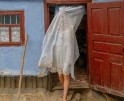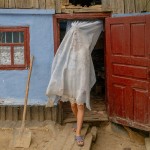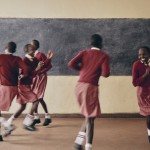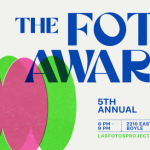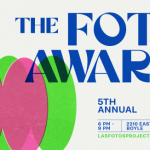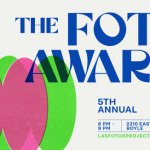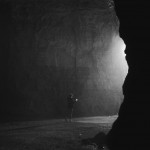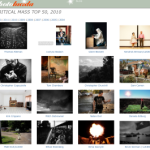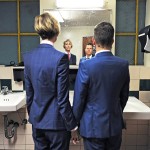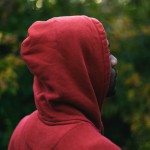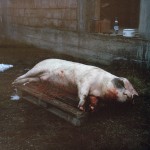Hearst Journalism Awards: Angelina Katsanis: 2022 First Place Photojournalism Winner
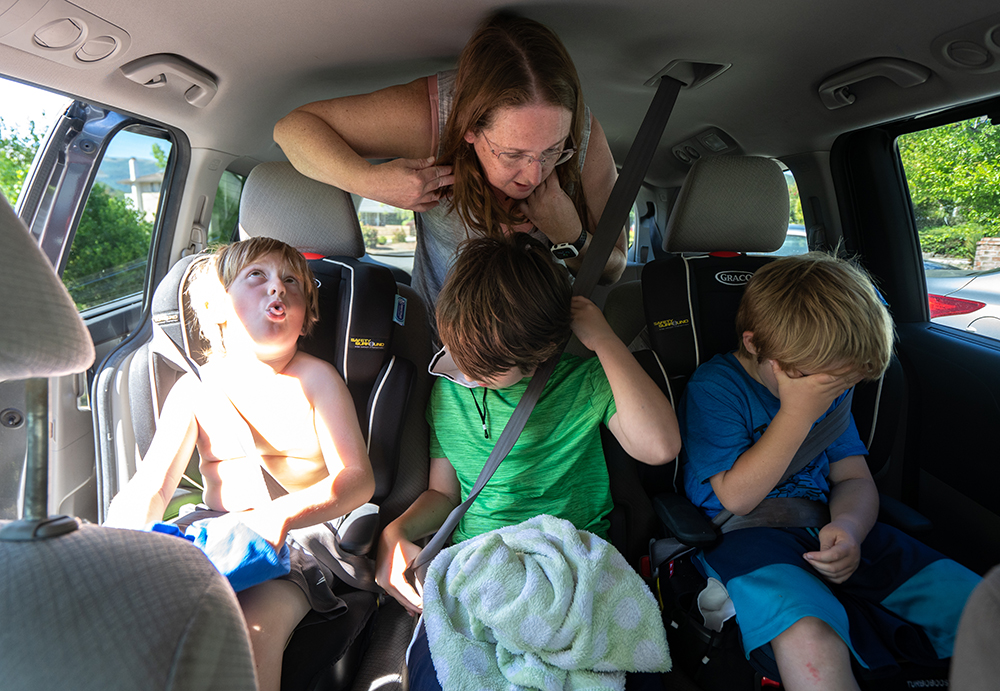
©Angelina Katsanis, Siobhán buckles in Reid, 6, Ryley, 9, and Jasper, Reid’s twin, as the family heads to the grocery store. She endearingly calls their minivan the “clown car.” With young boys, it always takes more time than expected to load everyone in.
This week we are celebrating photographers who have received a 2022 Hearst National Championship Award. Today we focus on National Photojournalism Championship First Place Winner, Angelina Katsanis, from University of North Carolina at Chapel Hill, who received a $10,000 award for her project, A Mother’s Reclamation.
The Hearst Championships are the culmination of the 2021 – 2022 Journalism Awards Program, which were held in 103 member universities of the Association of Schools of Journalism and Mass Communication with accredited undergraduate journalism programs. From May 20 – 25, 2022, 29 finalists – winners from the 14 monthly competitions – participated in the 62nd annual Hearst Championships in San Francisco where they demonstrated their writing, photography, audio, television and multimedia skills in spot assignments. The assignments were chosen by media professionals who judged the finalists’ work throughout the year and at the Championships.
Originally from Durham, North Carolina, Angelina Katsanis is a visual journalism student at the University of North Carolina, Chapel Hill, double majoring in Journalism and Social and Economic Justice with a Studio Art minor. Her fine art background plays an important role in her journalism and works with her curious and extroverted side to tell visual stories of the people she meets and places she goes.
Follow Angelina Katsanis on Instagram: @akatsmedia

©Angelina Katsanis, The twins’ birth was a traumatic one. At nearly 38 years old and a belly double the normal size, Siobhán was put on bedrest at only 14 weeks pregnant. At 29 weeks, complications caused the birth to become a medical emergency and she went into cardiac arrest. As soon as she came to, the doctors decided to deliver the twins early. The epidural then sent her into a stroke. While she was unconscious, she needed to be cut hip to hip if the babies were to survive. “Usually, everyone who gets a C-section has this really cute bikini scar. Mine is not that. I have a massive, beautiful one,” Siobhán said.
A Mother’s Reclamation
A perpetual optimist, Siobhán Gibson is a mother of four sons who has been through a great deal during her life—from an abusive ex-husband to family deaths to traumatic pregnancies. She works for an oncology clinic where she counsels hundreds of patients with cancer. But every day, she comes to work with a smile on her face and an open heart, and then comes home to spread the same warmth to her rambunctious boys and husband.
“Every day I tell people that they’re dying, so I want to be that breath of sunshine. But being that perky breath of sunshine is exhausting.”
Her one respite from her selfless life? Pole dancing. Though she didn’t expect her path to lead to it, she has been dancing at a studio in Novato, California for three and a half years and her love for it grows every day. Pole dancing pushes her to be active, express herself and to do something that is just for her. “It’s good for my body. It’s good for my soul,” she said.
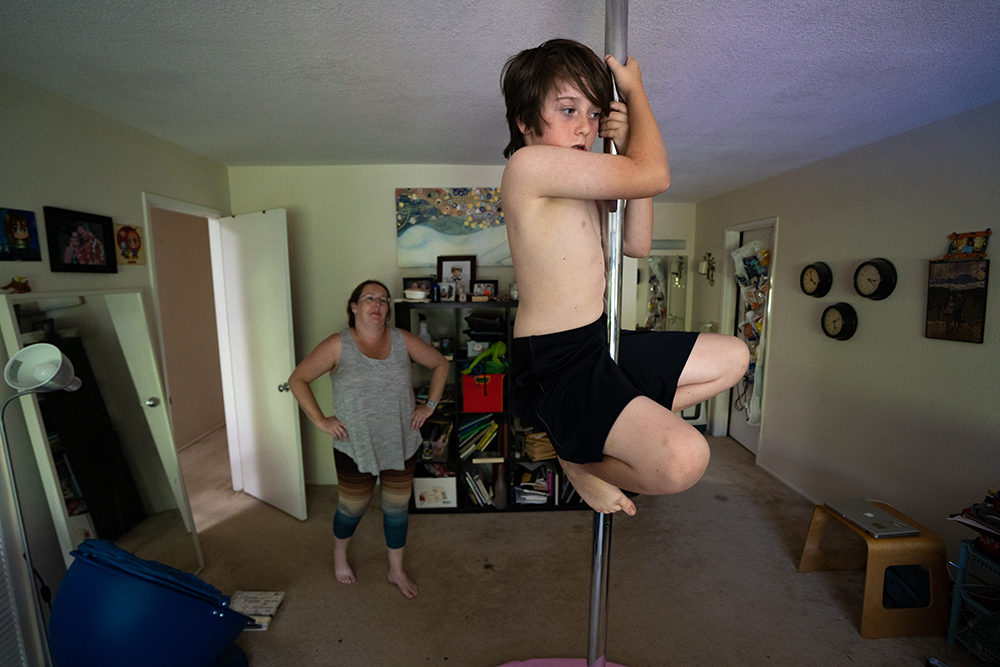
©Angelina Katsanis, Ryley, the middle son, scales to the top of Siobhán’s dance pole in the master bedroom. Siobhán stumbled into pole dancing in January of 2019 when she saw a new studio in her small town, “Entangled and Sway,” that she thought was for tango classes. After realizing what it really was, she decided to go for it anyway, thinking it’d be a fun way to reclaim her body after such a destructive pregnancy. She became hooked and now dances three times a week in addition to the practice she does on the home pole her husband Jason bought for during the pandemic.
Judy Walgren: Could you tell me a little bit about yourself? Where did you grow up and and what brought you to photography?
Angelina Katsanis: Yeah! I grew up and spent my younger years in Baltimore, Maryland, but mostly I’m from Durham, North Carolina. As far as photography, I first picked up a little pink Canon point-and-shoot when I was about eight years old and would take it on family vacations—shooting nonstop. My parents would be like, “Oh, that’s so cute! She’s bringing her little camera!” And then they saw that the pictures weren’t bad for an eight-year-old, old so they encouraged me to keep pursuing photography. And I did.
However, most of my life, I have pursued science and wanted to be a neuroscientist. All through high school, I got more and more into dark room photography. I did a lot of analog work and experimental printing processes in the dark room. I kept up my passion for photography as a fine art while I was pursuing science in high school.
It wasn’t until my freshman year of college that I had this personal crisis around what I wanted to do. I had joined the newspaper at UNC, the Daily Tar Heel, and I was shooting for the yearbook. I was also taking photo classes and realizing that I really loved the photography that I was doing way more than I’ve ever loved the science that I did.
So, I made the leap—which was hard—but I told myself that it’s got to be all or nothing. I’m going to put everything I’ve got into photojournalism.
I love photography, but I’m more attracted to the photojournalism side than the fine art side for the same reason that I like neuroscience. It’s about understanding humans and explaining society and what makes us who we are.
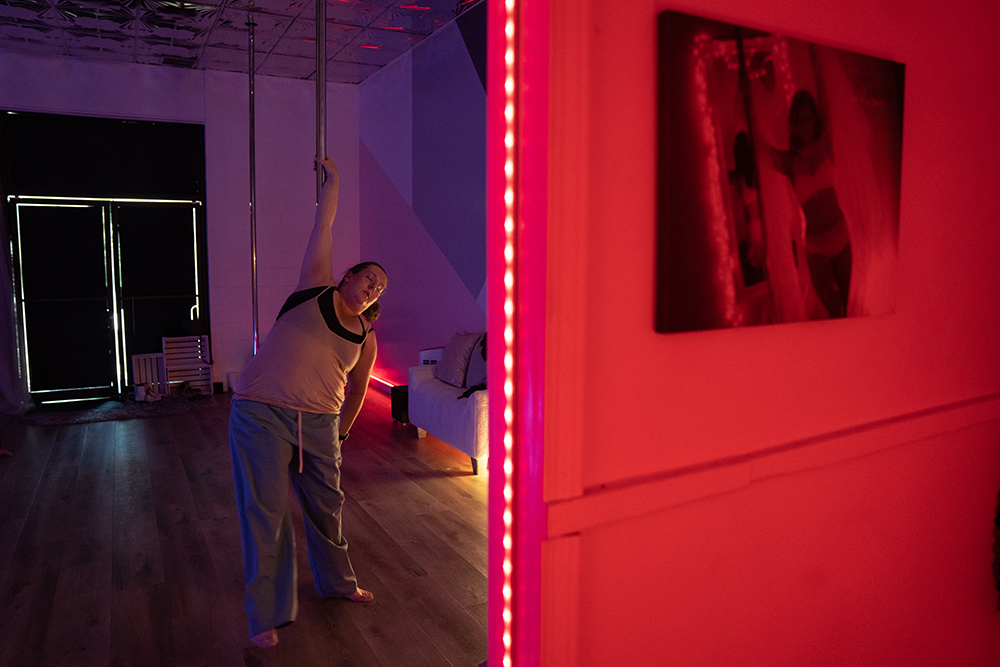
©Angelina Katsanis, Pole dancing also became a way to stay body positive and for Siobhán to express herself with her quadruple-postpartum body. “It’s really hard sometimes to not compare myself to other women. But I have to remember that they didn’t have four children,” Siobhán said. “I don’t even weigh myself anymore. It’s not worth it.”
Judy: Yeah. Same for me. I was approaching years into a pre-med degree, and I just couldn’t do it anymore.
Angelina: Yeah, it was. It was hard—especially because both my parents are both scientists. Since the beginning of high school, I was doing independent research, but I just couldn’t see myself sitting in a lab for the rest of my life.
Judy: Yeah, organic chemistry was the class that killed it for me. But I loved the aspects of research and helping people. Do you believe it was the way that you were raised that created your attraction to photojournalism?
Angelina: I’m a people person. I love talking and learning about people. And I was raised by scientists and raised to be a curious person—to always question everything. So, maybe that’s what made me want to be a photojournalist. I am also an artist and I want to tell stories in unique ways so that people feel encouraged to learn more about them and to be curious, themselves.
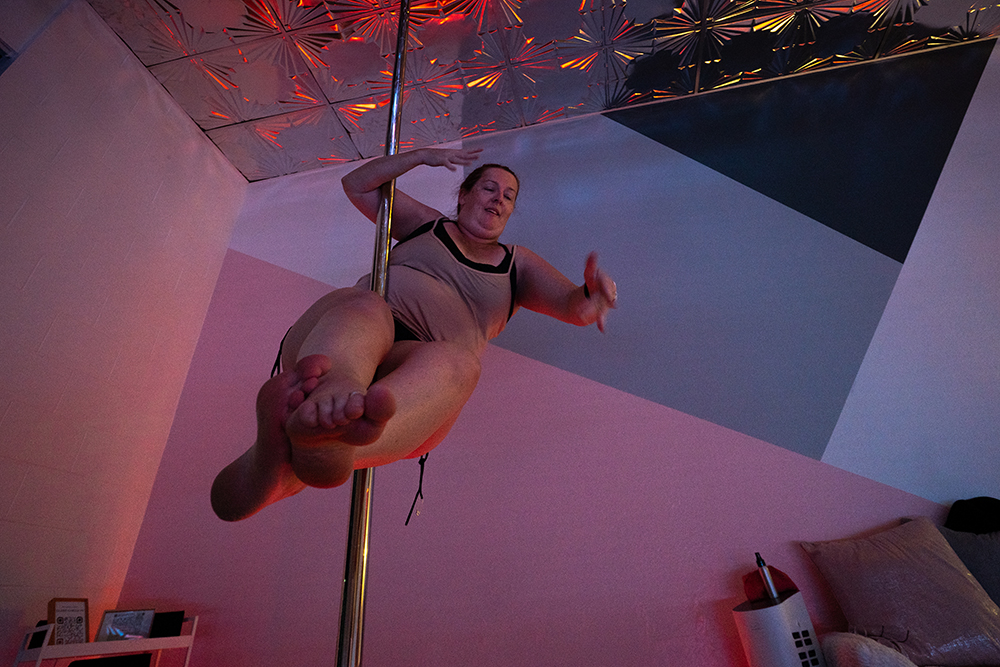
©Angelina Katsanis, After losing all her core strength from the pregnancy, Siobhán has come a long way in her pole dancing abilities. She had also been a dancer throughout her childhood, so it’s empowering to reignite her love of dance through pole. She had been working on this particular move for a long time and now executes it on the first try. “Pole is great! On my 44th birthday I learned how to twerk!” Siobhán said.
Judy: I really like what you just said about being an artist, because when I was growing up and growing into photojournalism, calling yourself an artist was considered a bad word. A lot of my work now as an instructor has been around dismantling the negative connotation that the word “artist” has in the photojournalism world and vice versa – the negative connotation that “photojournalist” has in the art world. The ethical considerations for both areas are super important. You can be both an artist and a non-fiction visual storyteller.
Angelina: I’m a double major in journalism and studio art, and I have faced that push back like you said, both from the journalism side towards the artist and the artists towards the journalists. Really the best work is going to be the combination of both storytelling and artistic vision. I think my fine art background and my dark room photography have shaped the way I see the world and my perspective on images as art forms, as opposed to pure documentation. It’s really a balance between documentation and art and creativity.
Ethically, we can still take any setting, any truth, and make it beautiful without twisting the narrative, and that’s part of our job as photojournalists to document what is happening and show it in the best way we can.
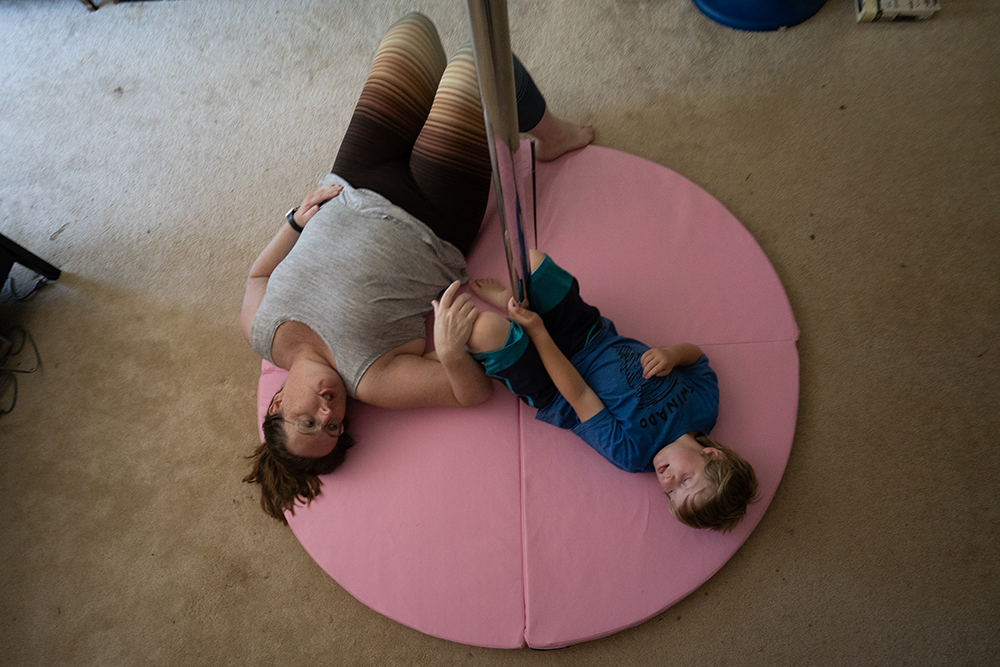
©Angelina Katsanis, Pole dancing came at the perfect time in Siobhán’s life. “I love my children and I love what I do at the clinic, but I needed something that was just for me,” she said. “Something not dedicated to my children or to dying people.”
Judy: Okay, so this notion of objectivity versus seeking the truth—where do you see yourself operating between the spaces of objectivity and truth/fairness?
Angelina: As journalists, do pursue the truth. But you know, as I’m entering my last year of university, I’ve learned in journalism that truth is not objective, and each person will have their own truth. We have to figure out, as best we can, what our subject’s truth is, and document that—not our version of what the truth is.
Take my Hearst story, which is about someone with a complex and layered life that I could only fit into 12 to 15 images. So, I cannot tell her whole completely, but it was my job to use what she provided to me—what she offered to me—to try and craft one piece of her truth. As journalists, all we really want is for our stories to be read by our subjects and for them to feel that, “This is me.” I hope that I did a good job of that with Siobhán’s story, even though I couldn’t show every single aspect of her life.

©Angelina Katsanis, Siobhán takes a break from the constant demands of motherhood while the twins nap downstairs. “One thing about this house is that it’s never quiet. You really learn to appreciate those moments where it is,” Siobhán said.
Judy: So moving to your Hearst story on Siobhán, how did you come up with it and then find someone to follow?
Angelina: The story prompt was self-expression and the California Dream, and I’ve always been interested in motherhood stories. So, for some reason, one of my ideas I had was to find a mother who is a pole dancer. So, I reached out to a bunch of different pole studios in and around San Francisco saying I would like to work on a story about people who are pregnant that pole dance if you have if any students who might be interested? And then Siobhán emailed me saying she was a mom who enjoyed pole dancing. And then her story ended up being so much more.
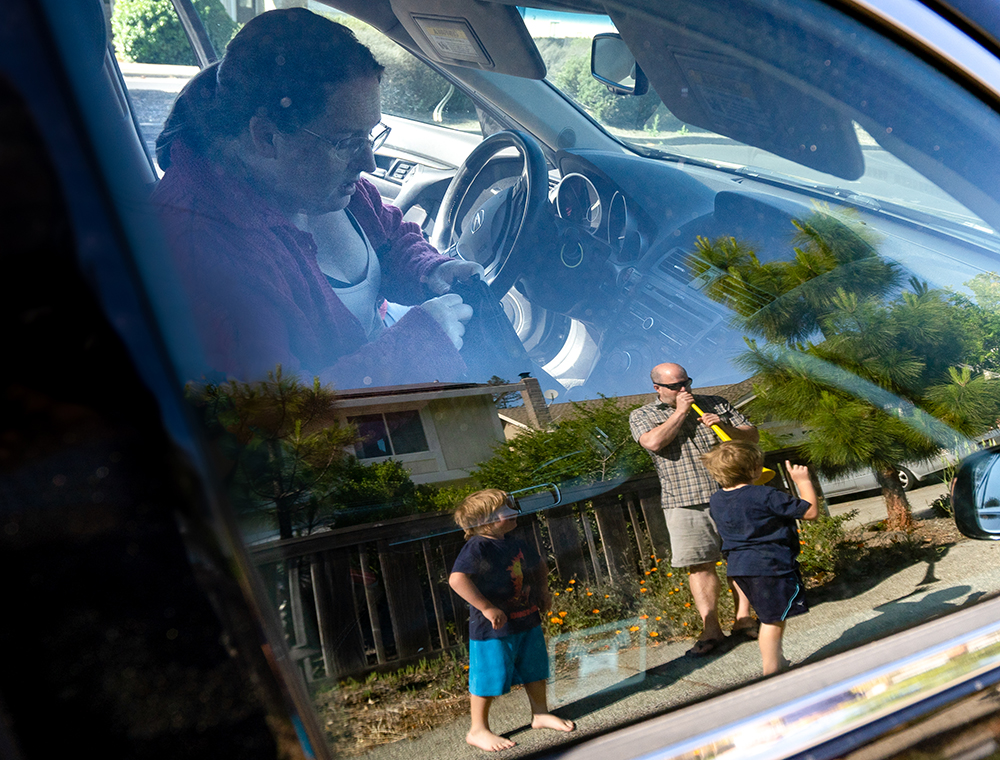
©Angelina Katsanis, clucking like chickens. She did this “chicken dance” one day with her oldest son as a joke when her husband was leaving the house, and it stuck. Now, every time someone is leaving, the kids run up and down the driveway flapping their arms and clucking until the person leaving is out of sight.
Judy: Where did the idea for pole dancing come from?
Angelina: Honestly, I have no idea! I was thinking about self-expression, and then thought about pole dancing and how we make assumptions about it. Siobhán says she has a pole in her bedroom, and everyone asks, “Oh, so do you pole dance for your husband? And she’s like, “No i’ve never actually ever performed for him. It’s truly just for myself.” I feel like everyone gets into pole dancing for their own individual reasons and that hits the bill for individual expression.
Judy: So, in terms of the experience in San Francisco, what was like the main takeaway?
Angelina: it was an amazing experience. All the photo finalists became super close. We clicked pretty much instantly and helped each other with our stories. It didn’t feel like a competition. It felt like we were all doing what we loved to do and doing it together.
Judy: Can you share the names of any photographers whose work has influenced you?
Angelina: Henri Cartier Bresson is my favorite. I actually have a tattoo from one of his photographs because he’s one of the first photojournalist/artist, you know. He comes from both backgrounds, and he paved the way for photojournalism as an art form. I’m in love with his concept of the decisive moment—when time and space align to compel the photographer to press the shutter button. I also follow Gabriela Lurie’s work from the (San Francisco) Chronicle and Lindsay Addario’s work for The New York Times. And I love Matt McClain’s work from the Washington Post. I’ve been keeping up with his work as I’ve grown as a photojournalist and like how he uses light, shapes and layers.
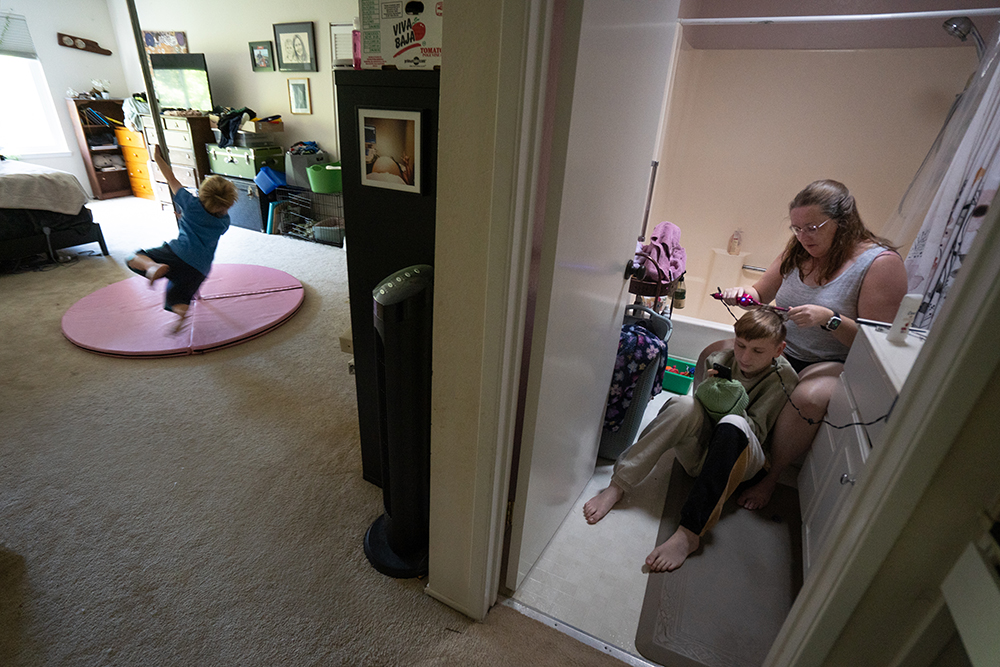
©Angelina Katsanis, Siobhán curls her 16-year-old Finn’s hair while Jasper horses around on his mom’s at-home pole. Due to HIPAA regulations, Siobhán can’t talk about her work life with her family and therefore has to keep the heaviness of the job to herself. “I know so many dead people. My kids don’t know any of them,” Siobhán said. “One of my favorite patients actually died today. I’m really sad, but have to just keep going.”
Judy: Do you have any thoughts about where you’re headed, or are you still trying to figure that out?
Angelina: Yeah, I think in an ideal world, I would love to land a staff job. I like the buzz of the daily newsroom and I like working with writers and news teams. I’m currently at the News and Observer as an intern and that’s been an awesome experience being able to have a different assignment every day and go out and do what I love. I also want to move abroad, possibly. I have family in Europe, and I’ve spent a lot of time there. But who knows?
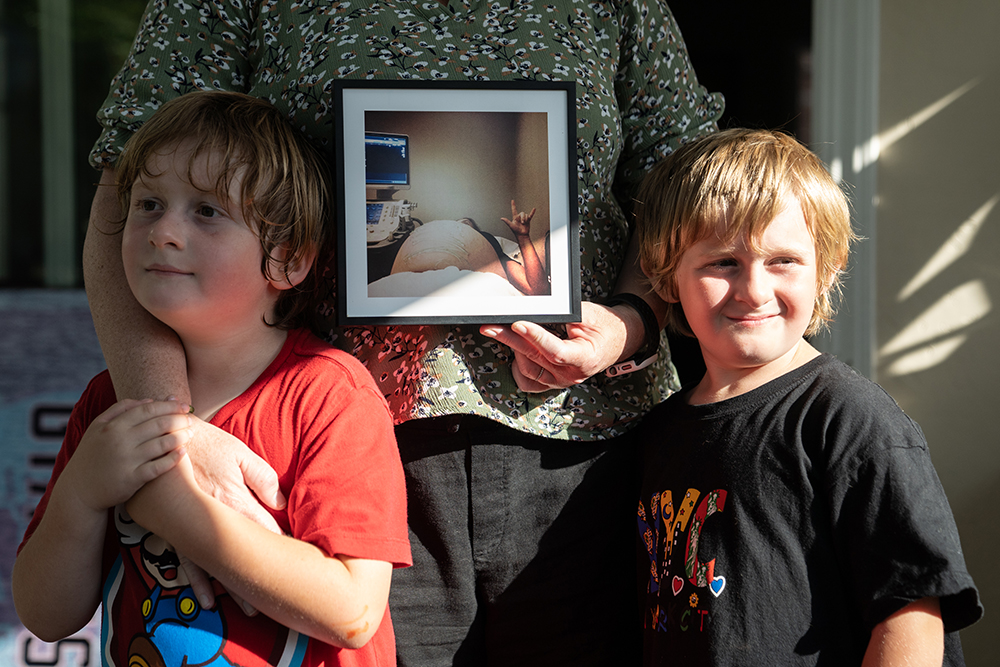
©Angelina Katsanis, Reid (left) and Jasper stand with their Mama and the photo of her bedridden at only six months. Less than a month later, the babies were born weighing in at three pounds and four pounds.
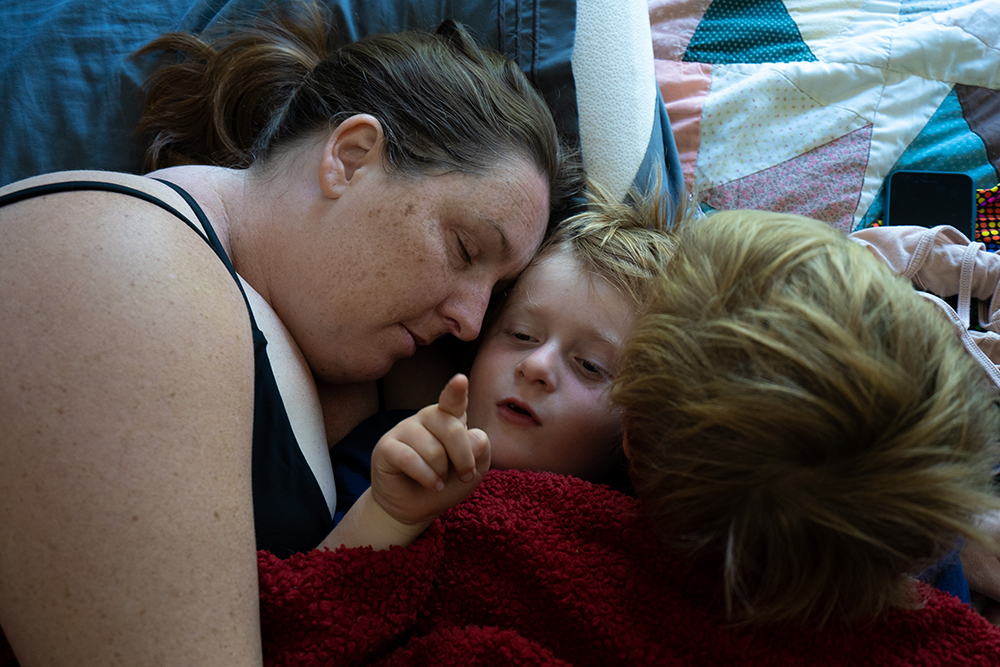
©Angelina Katsanis, Siobhán and the twins cuddle together on a lazy Sunday morning at home in Novato, Calif. on Sunday, May 22, 2022. She said that she stays positive through everything going on because ultimately what matters most is her family. “We tried for just one girl,” she joked. “But instead I got these two more boys and I wouldn’t want it any other way.”
MSU J-School Associate Director and Professor of Practice Judy Walgren is an award-winning photographic artist, teacher, photo editor, curator and writer. received her MFA in Visual Art from the Vermont College of Fine Art in January 2016 where she began her exploration into the disruption of historic visual archives. From 2010 to 2015, she was the Director of Photography at the San Francisco Chronicle, where she managed a staff of visual content producers, photo editors and pre-press imagers for print and digital platforms. During her tenure at the Chronicle, her team won multiple Emmy Awards for their multimedia pieces and they earned Photo Editing Team of the Year from Best of Photojournalism. She has also worked for the Denver Post, The Rocky Mountain News and the Dallas Morning News. Walgren received a Pulitzer Prize for International Reporting with a team from the Morning New for their series dealing with violent human rights against women. She lives in San Francisco.
Follow Judy Walgren on Instagram: @judywalgren
Posts on Lenscratch may not be reproduced without the permission of the Lenscratch staff and the photographer.
Recommended
-
The International Women in Photo Association Awards: Lorraine Turci: The Resilience of the CrowMarch 16th, 2024
-
The International Women in Photo Awards: Natalia Garbu: Moldova LookbookMarch 15th, 2024
-
The International Women in Photo Association Awards: Rayito Flores Pelcastre: Chirping of CricketsMarch 14th, 2024
-
The International Women in Photo Association Awards: Alena Grom: Stolen SpringMarch 13th, 2024
-
The International Women in Photo Association Awards: Louise Amelie: What Does Migration Mean for those who Stay BehindMarch 12th, 2024


